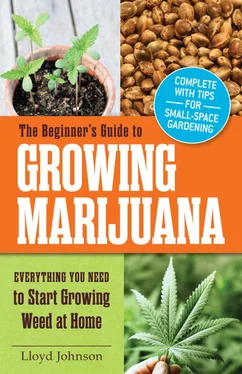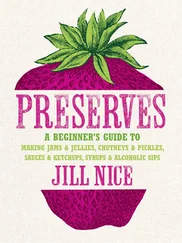When choosing a container for your cannabis, there are three important rules to remember:
1. The container must be able to hold soil.
2. The container must be large enough for the plant to grow to maturity.
3. Water must be able to drain easily from the bottom of the container so the soil does not get waterlogged.
The container can be any shape so long as it can fulfill these three essentials. There is an enormous variety of useful containers available. Pick your containers based on availability, cost, and efficiency. The size of containers you use for mature cannabis plants will, in part, be determined by how big you can allow the plants to get. If you live in a suburban townhouse and are growing a few on your deck, you will want to keep the plants small to avoid detection and theft. Cannabis plants are somewhat like goldfish; they will generally grow to fit their space. A ten-foot sativa towering on your balcony will be noticed by even the most unobservant passerby.
Containers can be purchased at your local nursery or hardware store. The most common kinds available are traditional oak barrels, pots made from reconstituted paper, terra cotta, ceramic, wood, plastic, and resin. If you are planning to grow your vegetables in a container for several years choose a good quality one that will last. Containers need to be cleaned on a regular basis to keep them looking good, as well as pest- and disease-free, so choose a container that you can take care of easily.
To save money, you can recycle items that are no longer fulfilling their original purpose. Some ideas for small containers for growing plants, for example, are tin cans, bricks with a center opening, milk cartons, a bucket, or an old cooking pot (a great place to use that kitchen pot that got burnt and will never come clean again!). When you purchase garden pots, there usually are holes in the bottom of them already; however, if you are recycling a container, make sure you make at least one good drainage hole so excess water can easily drain.
Some popular containers include:
Small Containers
Say you plan to grow four plants on your deck. You have access to water, and ideally already have some general plants out there, including herbs and container tomatoes. To simplify, you start with clones, so you know they are females. You have identified the sunniest spot and checked that taller buildings do not overlook your deck.
Money Smart
The least expensive way to go is to use recycled nursery pots. These can come from a friend who has recently purchased and ground-planted large shrubs, or nurseries will frequently give used plastic pots away or sell them for a nominal fee. Ones used for baby trees can be quite large—up to fifteen or twenty gallons in size. If you are using recycled pots, give them a thorough cleaning, including wiping with a light bleach solution and then rinsing with clear water. This will eliminate any harmful fungi or bacteria that may have been in the previous soil. Most nursery pots lack enough drain holes, so take a drill to the bottom and double the drain holes. Put in a bottom layer of drain rock to improve drainage.
Since you are keeping your plants small, go for the five-gallon pots; the taller variety seems to work better than the shorter, fatter version. They both hold five gallons of soil, but the taller pots suit the growing style of the cannabis a bit better. Of course, if all you can find are the shorter pots, cannabis will accommodate you and adjust itself accordingly.
Wine Barrels
Another, more elegant, solution for containers is recycled oak wine barrels. In the early heyday of cannabis growing in 1970s Mendocino County, wine barrels were cheap. The California wine industry was growing rapidly at this time, and the barrels were not typically reused once wine had been bottled. If purchased directly from the winery, the whole barrels also had the interesting benefit of frequently containing up to a gallon or so of good wine to be salvaged! Now wine barrels are sold as half barrels for $20 and up.
While wine barrels are attractive, breathe well, and have excellent drainage, they are also expensive, hard to clean, and will eventually rot. If you are going to use half barrels, make certain to get your drill out and make multiple drain holes in the bottom. The wine barrels hold more soil, so be prepared for your plants to get quite large. With the right feeding and watering, a sativa cross grown in a half barrel can easily reach eight feet in height.
Keep It Simple
It might seem obvious, but be careful and think ahead when using power tools to make drain holes. Drilling through the bottom of a container is simple until you figure out you just drilled through too far and made holes into your (or your landlord’s) nice deck. Flip the container over for this activity!
Plastic Barrels
Less elegant, but much cheaper and lighter to move when empty, are food-grade 30-gallon plastic shipping barrels. Each barrel can be cut in half to yield two containers. The plastic is very tough, but still easy to drill through and cut. If you are lucky enough to live near a port, do some telephoning and find a source for the used barrels. They must be rated food-grade, which means they originally contained something like soy sauce and not motor oil. Used barrels are sold clean and typically the whole barrel will cost somewhere between $8 and $15. The plastic barrels will last for years, unlike the similar-sized oak half barrel.
Sometimes food-grade barrels come in bright colors like light blue, but the plastic will hold paint well. It is advisable to paint the outside surface with more natural colors (various greens, light browns; think camouflage again) so the barrels don’t stand out too much. If you are planting a mixed garden totally in barrels, this is less of an issue. It’s obviously not a good idea to have just the cannabis in bright containers, as it will draw attention specifically to the cannabis. You want the cannabis plants to blend in with your other garden plants.
Again, as with the half wine barrels, the plants will get quite large with so much growing space. Outdoor growers who experience vole or gopher problems with direct ground planting frequently use food grade barrels. The barrels can be half-buried in the ground for less visibility. If you use this option, be sure to make extra drain holes, as the barrel will drain more slowly when buried. If voles or gophers are a problem, place a protective screen of chicken wire over the surface of the half-buried barrel to prevent rodents from top burrowing into your container.
Grow Bags
Grow bags are another economically sound container solution for the grower. The main disadvantage is the need to support the bag and plant as the plants get large. These are mainly advised for the grower with a larger crop. They also come prepacked with peat or compost, so you have less control over your soil mix. Peat-free composts are improving, but most people still find peat bags give the best results.
If you are starting out in coldish spring weather, warm the bags. Either store inside a heated room for a few days or cover with black plastic sheeting in the sun. This will take the chill off and warm the compost. Young plants crave warmth. Preferably wearing gloves, shake the bags hard to loosen the compost and prick the bottoms with a knife or a garden fork for drainage before putting them in their planting positions.
One disadvantage of grow bags, unlike hard pots or barrels, is their need for support. You can either set up supports for tall plants against a wall, hammer stakes into the ground around the grow bag, or purchase a self-supporting grow bag frame. You will also need to position your watering aids before planting. Trying to do this later will disturb the plant’s roots and slow growth.
Читать дальше












